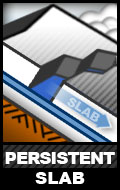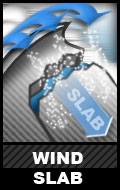This is a regional backcountry avalanche forecast for the Western Chugach Mountains of Chugach State Park. It is provided pro bono by a local avalanche professional, is based on limited field data for a large area, and is meant to be used only as a general baseline for recreationists’ personal and specific assessment in the field. The Anchorage Avalanche Center and associates assume no responsibility or liability for the use of this information. Anyone using this information needs to be formally educated in regard to avalanches and backcountry travel. Please encourage statewide investment in high quality outdoor and environmental education via K-12 public schools, as this is the best way to ensure all Alaskans are “avy savvy.”
Click the hyperlinks and icons for further learning.
Get outside and enjoy The Greatland! This is your weekend avalanche outlook for February 14-16, 2020.
The avalanche danger this weekend is expected to be considerable. This is based on the “travel advice” section of the danger rating as careful snowpack evaluation, cautious route-finding, and conservative decision-making will be essential for staying safe given the persistent slab danger. The “likelihood” and “size & distribution” sections are more characteristic of the “moderate” danger rating (click the icon below to view the entire danger scale).
Extensively faceted snow that developed during the cold and dry month of January is now a buried persistent weak layer overlain with hard slabs of varying thickness and hardness. This sort of hard slab problem is both difficult to assess and manage. Such avalanches may break above and around a human trigger, making escape difficult. The hard slab nature of the debris makes trauma more likely.
Relatively fresh wind slab avalanches are also possible this weekend. Active wind loading has been observed from South Fork to Turnagain Arm the past couple days, despite some area weather stations reporting light winds in the alpine.
Problem 1 – Persistent Slab
Human triggered persistent slab avalanches are possible on terrain steeper than 35º above 2500′ on all aspects. The persistent slab problem is low probability, but high consequence. A persistent slab could fail catastrophically and produce a large avalanche up to D3 in size. A human triggered persistent slab may be very difficult to escape. The trigger may be able to get into the middle of the slab before it releases from above with hard slab characteristics.
A snowpack consisting of heavily faceted snow (weak layer) overlain by dense, wind-packed (hard slab) layers has been found throughout the Western Chugach. Snowpits and stability tests are evidencing propagation propensity. Stout wind-packed layers may be able to bridge the weight of a human trigger, but if a weak spot is found (likely where the wind-packed, hard slab layer is thinner and/or less supportable) a dangerous avalanche could result.
There is no effective way to manage this problem other than simply avoiding terrain capable of producing a large persistent slab avalanche, especially big and steep slopes. Assessment of the persistent slab problem in the specific area in which you’re traveling will require thorough snowpack investigation: digging a snowpit, analyzing the stratigraphy, and conducting stability tests like the ECT. As always, be mindful of red flags (especially recent avalanches, collapsing or “whumphing,” shooting cracks, active loading, etc.) and very diligent about safe travel protocols.
Problem 2 – Wind Slab
Human triggered wind slabs up to D2 in size are possible on leeward terrain (especially west clockwise through north aspects) steeper than 35º above 2500′.
Chugach State Park has seen a couple bouts of modest snowfall since last weekend. Weak interfaces exist in the recent snow in some areas, and where this setup exists fresh wind slabs have been very reactive to human triggers. Fresh, small wind slabs may continue to build through the weekend.
Be on the lookout for red flags of wind slab danger (recent avalanches, shooting cracks, active wind loading). Paying close attention to the appearance and texture of surface snow is a way to identify potentially dangerous, wind-loaded terrain. Wind-loaded snow may look pillowy, bulbous, relatively deep (“fat”), and have a buffed or etched texture. Dangerously wind-loaded snow may feel hollow and punchy, indicating a denser slab overlying looser and weaker snow. Pole probing and quick hand pits are a great way to assess wind slab danger near the surface. Expert skiers and backcountry travelers may be able to use prudent ski cuts to manage the wind slab problem. Wind slabs have the potential to “step-down” and trigger larger and more dangerous persistent slabs.
Problem 3 – Cornice Fall
Cornices have been gradually building, are large in some areas, and dangerous human triggered cornice falls are possible on leeward terrain (primarily west clockwise through north aspects) above 2500′. Give corniced ridges a wide berth; cornices may break off further back than expected. Do not approach the edge of a snow-covered ridge, unless you’re sure it’s not corniced. A cornice fall itself is dangerous, especially if the human trigger falls onto exposed terrain. Cornice falls may also trigger wind and persistent slab avalanches as they “bomb” the slope they fall onto.
Danger Trend
Expect the danger to remain steady through the weekend, and increase Monday as significant wind and snow is possible.
Mountain Weather
Expect daytime alpine temperatures in the teens, with generally light winds, and a slight chance of light snow.
Best wishes for your weekend!
Please let us know what you’re seeing by tagging us on Instagram @anchorage_avalanche_center, submitting an observation, sending an email to info@anchorageavalanchecenter.org, or via FaceBook message. All observations help us provide the public with a better forecast product – no matter how basic. We are more than willing to keep observations confidential, and only use the information to inform forecast products.
Funding and resources for this forecast generously provided by the Post-Capitalists and Libertarian Socialists of Alaska who encourage you to feel the Bern, dump Trump, recall Dunleavy, and tell Murkowski, Young, and Sullivan to GTFO!



